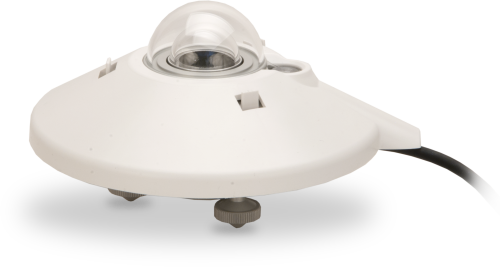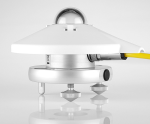
Internal thermistor for optimized measurements






Overview
The CMP21, manufactured by Kipp & Zonen, is an ISO Class A (secondary-standard) pyranometer with an internal thermistor. It monitors solar radiation for the full solar spectrum range, and is well-suited for scientific use and in top-level solar-radiation monitoring networks. This pyranometer connects directly to a Campbell Scientific data logger.
Read MoreBenefits and Features
- Includes thermistor for individually optimized temperature compensation
- Compatible with most Campbell Scientific data loggers
- Integrated bubble level is visible without removing sun shield
- Desiccant-filled drying cartridge prevents dew from forming on the inner sides of the domes
- Compatible with the CVF4 heater/ventilator that keeps the domes free from ice and dew
- Measures reflected solar radiation when inverted
- Provides measurements in direct sunlight, under plant canopies, when the sky is cloudy, and in artificial light
Technical Description
The CMP21 measures solar radiation with a high-quality blackened thermopile protected by two glass domes. An internal thermistor allows individually optimized temperature compensation of the measurements.
The CMP21 has flat spectral sensitivity, from 285 to 2800 nm, that makes it ideal for applications in natural sunlight, under plant canopies, in green houses or buildings, and inverted to measure reflected solar radiation.
A desiccant-filled drying cartridge prevents dew from forming on the inner sides of the CMP21's domes. Campbell Scientific also offers the CVF4 heater/ventilator that keeps its domes free from ice and dew.
The CMP21 includes a white snap-on sun shield that reduces the sensor's temperature. A bubble level and adjusting leveling screws enable the sensor to be leveled without using a leveling base.
Images








Related Products
Compatibility
Please note: The following shows notable compatibility information. It is not a comprehensive list of all compatible products.
Dataloggers
| Product | Compatible | Note |
|---|---|---|
| CR1000 (retired) | ||
| CR1000X (retired) | ||
| CR300 (retired) | ||
| CR3000 | ||
| CR310 | ||
| CR350 | ||
| CR6 | ||
| CR800 (retired) | ||
| CR850 (retired) |
Additional Compatibility Information
Mounting
The CMP21 has a bubble level and two leveling feet, which allow it to be leveled without using a leveling base. This pyranometer mounts to a mast, crossarm, or pole (1.0 in. to 2.1 in. OD) via the CM255 or CM255LS mounting stand. The CMP21 should be mounted away from all obstructions and reflective surfaces that might adversely effect the measurement.
Specifications
| Sensor | High-quality blackened thermopile protected by two glass domes |
| Measurement Description | Monitors solar radiation for the full solar spectrum range |
| ISO Classification | Class A (secondary standard) |
| Spectral Range | 285 to 2800 nm |
| Sensitivity | 7 to 14 µV/W/m2 |
| Temperature Dependence of Sensitivity | < 1% (-20° to +50°C) |
| Response Time | < 5 s (95% of final value) |
| Zero Offset Due to Thermal Radiation | < 7 W/m2 (200 W/m2) |
| Non-Stability | < 0.5% (change/year) |
| Non-Linearity | < 0.2% (0 to 1000 W/m2) |
| Directional Error | < 10 W/m2 (up to 80° with 1000 W/m2 beam) |
| Tilt Error | < 0.2% |
| Level Accuracy | 0.1° |
| Impedance | 10 to 100 Ω |
| Operating Temperature Range | -40° to +80°C |
| Typical Signal Output | 0 to 15 mV (for atmospheric applications) |
| Maximum Irradiance | 4000 W/m2 |
| Expected Daily Uncertainty | < 2% |
| Dome Diameter | 5 cm (2 in.) |
| Width | 15 cm (5.9 in.) with shield |
| Height | 9.25 cm (3.64 in.) |
| Weight | 0.9 kg (2 lb) with 10.1 m (33 ft) cable |
FAQs for
Number of FAQs related to CMP21: 8
Expand AllCollapse All
-
The HMP60-L (with the Campbell Scientific cable) cannot be used with the 41003-5 10-Plate Radiation Shield without the use of additional hardware. For more information, refer to the Compatibility information on the HMP60-L product page. The standard radiation shield for the HMP60-L is the 41303-5A.
-
In general, the element should be replaced every two years. By doing a field check (that is, comparing the RH reading with a reference), the element can be used until the relative humidity measurement is out of tolerance.
-
The most significant difference is that the CS215-L has an SDI-12 output and that the HMP60-L has a voltage output. Additional differences are outlined in the “Air Temperature & Relative Humidity” brochure, which compares all of the Campbell Scientific temperature and relative humidity sensors.
-
Most Campbell Scientific sensors are available as an –L, which indicates a user-specified cable length. If a sensor is listed as an –LX model (where “X” is some other character), that sensor’s cable has a user-specified length, but it terminates with a specific connector for a unique system:
- An –LC model has a user-specified cable length for connection to an ET107, CS110, or retired Metdata1.
- An –LQ model has a user-specified cable length for connection to a RAWS-P weather station.
If a sensor does not have an –L or other –LX designation after the main model number, the sensor has a set cable length. The cable length is listed at the end of the Description field in the product’s Ordering information. For example, the 034B-ET model has a description of “Met One Wind Set for ET Station, 67 inch Cable.” Products with a set cable length terminate, as a default, with pigtails.
If a cable terminates with a special connector for a unique system, the end of the model number designates which system. For example, the 034B-ET model designates the sensor as a 034B for an ET107 system.
- –ET models terminate with the connector for an ET107 weather station.
- –ETM models terminate with the connector for an ET107 weather station, but they also include a special system mounting, which is often convenient when purchasing a replacement part.
- –QD models terminate with the connector for a RAWS-F Quick Deployment Station.
- –PW models terminate with the connector for a PWENC or pre-wired system.
-
Not every sensor has different cable termination options. The options available for a particular sensor can be checked by looking in two places in the Ordering information area of the sensor product page:
- Model number
- Cable Termination Options list
If a sensor is offered in an –ET, –ETM, –LC, –LQ, or –QD version, that option’s availability is reflected in the sensor model number. For example, the 034B is offered as the 034B-ET, 034B-ETM, 034B-LC, 034B-LQ, and 034B-QD.
All of the other cable termination options, if available, are listed on the Ordering information area of the sensor product page under “Cable Termination Options.” For example, the 034B-L Wind Set is offered with the –CWS, –PT, and –PW options, as shown in the Ordering information area of the 034B-L product page.
Note: As newer products are added to our inventory, typically, we will list multiple cable termination options under a single sensor model rather than creating multiple model numbers. For example, the HC2S3-L has a –C cable termination option for connecting it to a CS110 instead of offering an HC2S3-LC model.
-
Note the difference between calibration and a field check. Calibration cannot be done in the field, as it requires an experienced technician and specialized equipment.
Field checks of measurements can be done to determine if the data make sense with the real-world conditions. Follow these steps to field check a sensor:
- Find a second sensor of the same type as the installed sensor whose data is in question. The second sensor will be used as a benchmark sensor and should be known to be accurate or recently calibrated.
- At the site, take readings using both sensors under the same conditions. The best practice is to measure both sensors side-by-side at the same time. Note that the sensors will never have the exact same measurement.
- Depending on the sensor model, if the difference in the readings of the installed and benchmark sensors is greater than the sum of the accuracies for both sensors, either return the installed sensor to Campbell Scientific for calibration or replace the appropriate chip.
- The 107, 108, 109, 110PV-L, and BlackGlobe-L temperature sensors can be calibrated.
- The HC2S3-L and HMP155A-L temperature and relative humidity sensors can be calibrated.
- The CS215-L has a replaceable chip for temperature and relative humidity. For more information, refer to the “Maintenance and Calibration” section of the CS215 instruction manual.
- The HMP60-L has a replaceable chip for relative humidity only. For more information, refer to the “Maintenance” section of the HMP60 instruction manual.
-
Many Campbell Scientific sensors are available with different cable termination options. These options include the following:
- The –PT (–PT w/Tinned Wires) option is the default option and does not display on the product line as the other options do. The cable terminates in pigtails that connect directly to a datalogger.
- In the –C (–C w/ET/CS110 Connector) option, the cable terminates in a connector that attaches to a CS110 Electric Field Meter or an ET-series weather station.
- In the –CWS (–CWS w/CWS900 Connector) option, the cable terminates in a connector that attaches to a CWS900-series interface. Connection to a CWS900-series interface allows the sensor to be used in a wireless sensor network.
- In the –PW (–PW w/Pre-Wire Connector) option, the cable terminates in a connector that attaches to a prewired enclosure.
- In the –RQ (–RQ w/RAWS Connector) option, the cable terminates in a connector that attaches to a RAWS-P Permanent Remote Automated Weather Station.
Note: The availability of cable termination options varies by sensor. For example, sensors may have none, two, or several options to choose from. If a desired option is not listed for a specific sensor, contact Campbell Scientific for assistance.
-
To incorporate a sensor that is compatible with wireless sensor interfaces into a wireless network, a CWS900-series wireless sensor interface is needed, as well as an A205 CWS-to-PC interface to configure it.
Privacy Policy Update
We've updated our privacy policy. Learn More
Cookie Consent
Update your cookie preferences. Update Cookie Preferences

